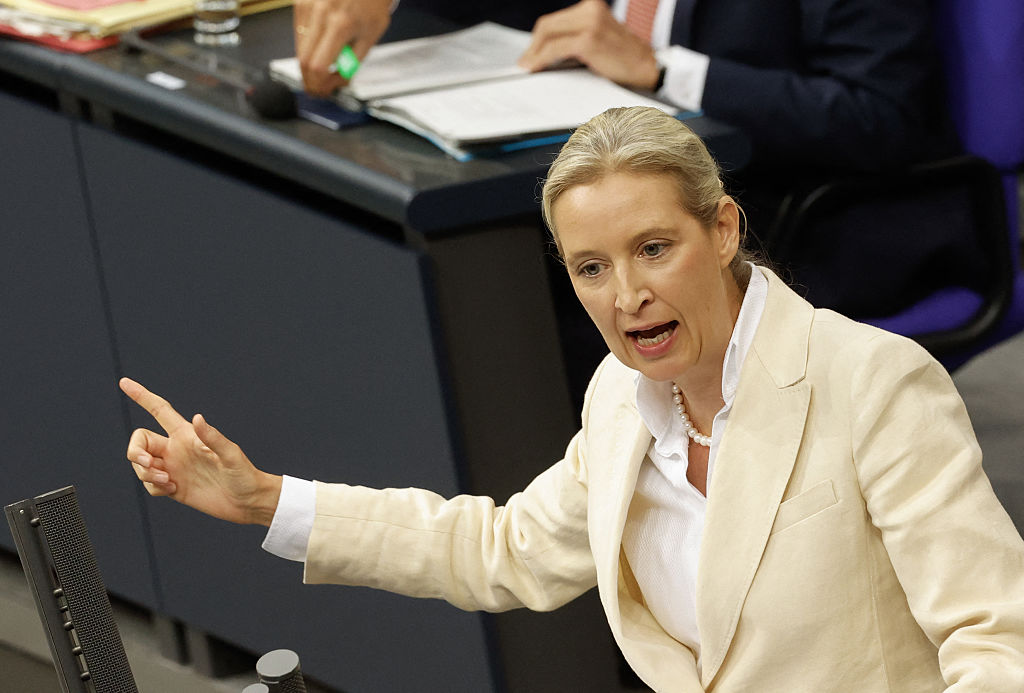Germany’s Far Right Wants to Trap the Left in Culture Wars
- Oscar Davies
According to a leaked strategy paper, Germany’s far-right Alternative für Deutschland sees socialist party Die Linke as a useful idiot that it can use to polarize society around culture-war issues. Die Linke shouldn’t play along.

The coleader of the Alternative für Deutschland (AfD) party, Alice Weidel, gives a speech during a general debate on the budget of the Chancellery at the Bundestag in Berlin, on July 9, 2025. (Odd Andersen / AFP via Getty Images)
Earlier this month, Politico leaked an internal strategy document from Germany’s anti-immigration Alternative für Deutschland (AfD). In a closed meeting, the AfD parliamentary group was shown a PowerPoint presentation titled “Introduction to the Strategy Process” that provided insight into the 3D chess the party is playing to outwit all its opponents.
The AfD wants to tear down the Brandmauer, or firewall — the mainstream parties’ informal pledge not to work with the far right — and turn the party’s leader, Alice Weidel, into Germany’s next chancellor. That’s all to be expected. What’s more interesting is that Die Linke, of all parties, is set to play a key role in this. The strategy paper envisions as a first bullet point a “cultural polarization between the AfD and Die Linke”: The AfD wants to instigate a contrived culture war with Die Linke in order to split the entire party spectrum into “bourgeois conservative vs. radical left.” Then the AfD would be left as the only possible partner for the governing Christian Democrats. The firewall would fall — and the AfD’s path to a position in the government, or even the chancellorship, would be open. That’s the plan so far.
The AfD is probably somewhat overestimating how “radical-left” the Social Democrats under their leader, Lars Klingbeil, and the Greens under Franziska Brantner really are. But there’s more to it than that. Die Linke can in any case be grateful to the AfD for making it so unmistakably clear that the culture war is a trap. Now they can more calmly hone their profile as a party focused on class-based politics, as important sections of the organization intend to do anyway.
The strategy paper not only reveals what the AfD wants from Die Linke but also implicitly makes clear what kind of left-wing politics it doesn’t find useful to its cause. It lists, for example, under the heading “Where We Are Strong” several demographics it intends to target with specialized working groups: “East Germans, rural areas, workers, Russian Germans, young voters” — demographics that a well-informed left should also focus on.
It’s obvious that the Left must rebuild its former strongholds in East Germany. Likewise, it should pay special attention to rural areas if it doesn’t want to become a party of “urban elites.” And it’s the most obvious thing in the world that a Left that claims to be a workers’ party must appeal to workers. In her successful direct-election campaign in Berlin’s Lichtenberg district, Die Linke party leader Ines Schwerdtner (a former Jacobin editor) showed that areas with a high Russian-German working-class population don’t necessarily have to be AfD territory. The fact that already in February’s federal election Die Linke could position itself as the strongest voice for young voters must also be causing some pain among AfD ranks.
If the AfD’s master plan truly depends on Die Linke jumping on command through “gender gaga” hoops (a derogatory term for identity politics around gender), then it should be easy to prevent their rise to power. The greater danger is that the far-right party might win even without a good strategy — simply because their opponents have no good strategy either.